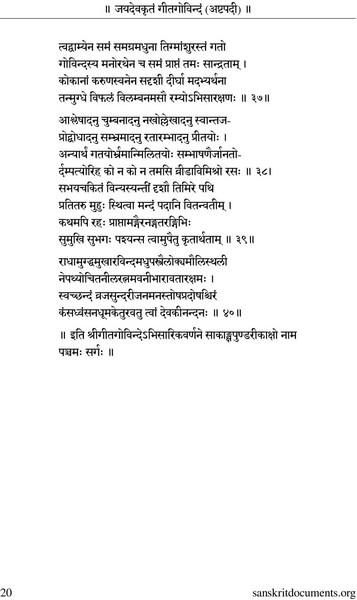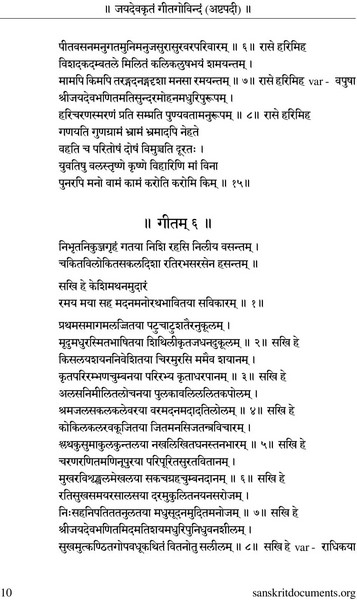Sri Krishna is with his wife Viraja in Goloka. Numega smartcheck 6.2 rc2 1. When Radha, on hearing about this, comes there in anger, Krishna turns Viraja into a river and hides himself. Radha returns to her abode disappointed only to be met by Krishna, who pretends to be in search of her calling out her name, “Radhe…Radhe.” When Radha turns her face away in anger, Krishna tries to pacify her. However, she would not be appeased. Even when Krishna entreats her saying, “Do not be angry, O Radha! I plead with you. I shall not be attracted to any other woman henceforth,” she does not relent.
The great devotee Sudhama is offended by Radha’s behaviour. Krishna, then, goes back to his love sport with Viraja. Radha, who could not bear to be separated from Krishna, sends her apologies to Krishna through a friend. Krishna replies to the message saying that he has no strength even to walk, because of the intense suffering caused by Radha’s separation and asks Radha to come to him. On receiving this message, Radha sets out to meet Krishna.
However, Sudhama, who is still angry with Radha, bars her entry into the place. Radha curses him to become an asura and he, in turn, curses her that she would be separated from Bhagavan Krishna. At this point, the Lord Himself comes out and effects a reconciliation between them. Sudhama is to be born as Shankachuda, would be killed by Shiva and would return to Goloka. Radha would be born as the daughter of Vrishabanu. The Lord assures her that he would be born as the son of Vasudeva, would grow up in Nanda’s household and would marry her. They were to live on earth for a while and then return to Goloka. This is the story sung by Jayadeva in the 24 verses of the Ashtapadi.
The events that happen in Goloka, as well as those that happen on earth are narrated in Jayadeva’s work. The Gayathri Mantra, the Mantra Raja, the mother of all Vedas, has 24 syllables. Based on the ratio of a thousand verses for each of the 24 letters, Valmiki composed the Ramayana in 24,000 verses. On a similar scale, Sri Thyagaraja Swamigal composed 24,000 keerthanas. Jayadeva, on the same basis, composed 24 Ashtapadis.
Since it is a song (gita) about Govinda, it is called the Gitagovinda. Since it is composed in eight padas (in keeping with rhythms of dance), it is also called the Ashtapadi. Several slokas are added to the songs in the beginning and in the end. Many writers have specified the raga and tala in which these verses are set. Yet others sing these as taught by their gurus. Macross plus game edition psx iso zone download.
Since it is considered a Kavya, a work of poetry, it is divided into sargas or chapters, like other kavyas such as the Raghuvamsha. This work has been composed in twelve sargas, bearing the Dvadashakshari mantra (twelve-syllable mantra) of Krishna. The names given by Jayadeva to each of these sargas are also unique and meaningful. They bestow grace upon devotees.
- Samoda Damodaran: He who gives joy to the mother who tied him to a mortar.
- Aklesha Keshavan: He who protected Brahma and Shiva.
- Mukta Madhusudanan: He who punished Madhu, the asura who was enslaved by Moha.
- Snigdha Madhusudanan: He who revealed his beauteous form to Madhu and Kaitabha.
- Sakanksha Pundarikakshan: He who awaits the arrival of his devotees with eyes wide open.
- Dhrishta Vaikuntan or Dhanya Vaikunthan: He who reveals the bliss of Vaikuntha to every one.
- Nagara Narayanan: He who can appeal to people of a city, though He had lived in a village among Gopis (cowherdesses).
- Vilakshya Lakshmipati: He who accepts every one who seeks his Grace as Lakshmi herself.
- Mukta Mukundan: The Guru who bestows a unique experience.
- Chatura Chaturbhujan: He who has four arms which grant all the goals of human life.
- Sannada Govindan: He who brings joy to cowherds and to every one on earth.
- Supreeta Pitambaran: He who, pleased by the devotion of his devotees, bestows upon them the Pitambara (the yellow garment worn by Him).
Ashtapadi Lyrics Pdf Online
These meaningful names explain the import of the Ashtapadi clearly. We have no knowledge of Moksha and the unknown is to be reached through the known. Moksha is unalloyed bliss and all other pleasures we experience are but drops of this Ocean of Bliss. This bliss is purely experiential. The sacred texts try to make us have a glimpse of it through the example of Sringara bhava known to all of us in our experience. Today’s world, following Western thought, understands Sringara bhava in terms of brutish lust. This is fallacious. Sringara bhava comes out of the perfect union between the husband and wife and is expressed in a harmonious life, sweet conversation, congenial behaviour, not being separated from one another, the misery felt if separation happens, offering music and dance, (a part of the worship of the Lord) to the god residing in the temple of the body, embracing one another, exchanging kisses and so on. How to use d2se modmanager.
Ashtapadi Lyrics Pdf Converter
This Nayaka-Nayaki Bhava is akin to the relationship between the Jiva and Ishwara, in aspects such as the experience of union and devotion. This Nayaka-Nayaki Bhava is not exclusive to our religion alone; it is found in Christianity and Islam too. Prema Bhakti is, thus, portrayed in the songs of the Thevaram, the Divya Prabhandam and in the songs of many other devotees. Though these appear to be erotic in nature, they are replete with ideas from the Vedantas and so are sung even by renunciates. The jiva is separated from the Paramatman and suffers several sorrows such as birth, death, old age, hunger and disease. By the grace of the Lord, the jiva finds a good acharya, who guides him aright and leads him to union with the Lord. Here, Krishna is the Paramatman, Radha the Jivatman, and the friend is the Acharya. Similarly our ancestors have written plays such as the Prabodha Chandrodayam and the Snakalpa Suryodayam which portray abstract qualities as a king – Prabodha, the King triumphs over the asura Ajnana who comes to battle accompanied by his army of Kama (desires) and Krodha (anger). The Padma Purana serves as a precedent to this.


